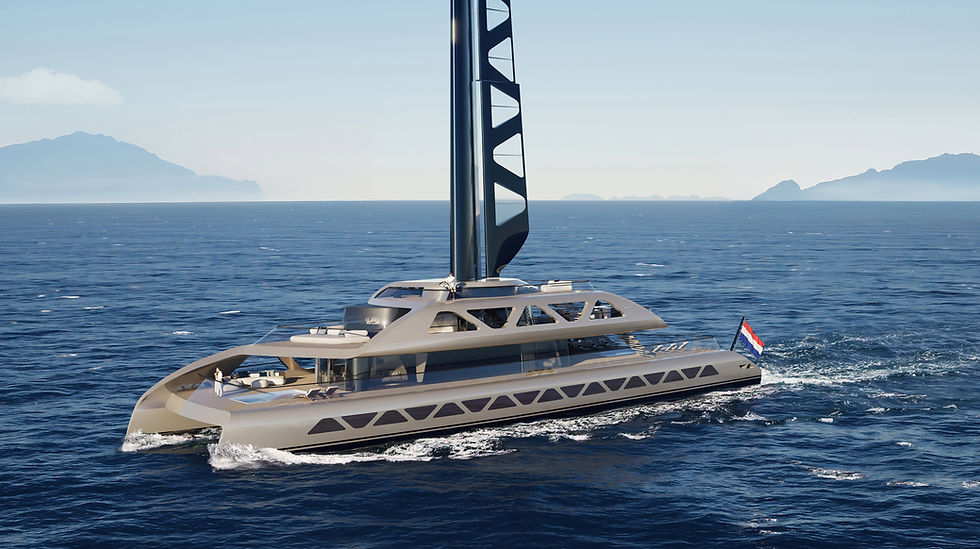Self-docking boats are about to become the new reality
- Boating-greece

- Feb 7, 2024
- 4 min read

This revolutionary feature relies on sensors, cameras and GPS technology to guide the boat safely and precisely to its docking point.
How do self-docking boats work?
They combine the following three elements:
Sensors and cameras:
Docking boats have sensors and cameras that monitor the boat's surroundings. These detect anything nearby, such as other vessels or obstacles. The self-adocking will also be located, ensuring a safe and accurate docking process.
GPS technology
The boat's built-in GPS talks to the boat's self-adjusting dock, sharing data about speed, direction and position. This information helps to find the best approach for mooring.
Connection algorithms
Self-docking boats use sophisticated algorithms to analyze data from sensors, cameras and GPS. This allows them to autonomously adjust their speed, direction and position for optimal alignment with the self-docking base - completing an effortless tethering process.

Three company partnerships are leading the way in making boat docking a hands-free experience.
advertisment:
Raymarine began development of a self-docking boats in 2017, when its engineers collaborated with counterparts at FLIR's Point Gray division. The idea was to use FLIR's 3D stereo vision camera systems to develop a close-range, hands-free maneuvering system.

Today, Raymarine offers two assisted docking systems. The first is DockSense Alert, which uses one, three or five stereo vision cameras to make visual images and alerts to the captain of any potential collision with another vessel or object. It detects objects above the waterline and creates an intuitive map of potential hazards around the boat.

The second system is DockSense Control, which adds to the DockSense Alert technology active intervention in case an impending collision is detected. Captains can virtually set the fenders in all quadrants without fear of hitting the boat on the dock or the boat next to them.
Avikus collaboration by Raymarine

Avikus is a subsidiary of Hyundai Heavy Industries, which is the largest shipbuilding company in the world and has experience in autonomous systems for ships. At last year's Fort Lauderdale International Boat Show, Avikus NeuBoat showed off the Navigation Assistant System and docking Assistant System, which seemed to work perfect. Using cameras along with LiDAR, the boat avoided any object or vessel within 400 feet.
This system also has a route planning function, allowing the driver to tap two points on the on-screen map. After that, the system will steer the boat along the safest route between the two points.
The captain chooses where the boat should dock and the system takes over.
The complete system consists of 6 Surround-View surveillance cameras, an Object Recognition Unit and a Camera Control Unit seamlessly connected to an Axiom cartographer display on the steering wheel.
Volvo Penta, Garmin

Volvo Penta and Garmin continue their long history of collaboration, making it possible to combine two independent systems - the Volvo Penta Assisted Docking and the Garmin Surround View Camera System.
Volvo Penta's self-docking prototype was in Sweden in 2019 in challenging 30 knot winds on an Azimut yacht. The system brought the 68-footer safely to the dock, albeit slowly, using sensors to detect beacons returning to the dock. Although this solution would not be useful outside of a boat's harbor, the demonstration proved that the concept works.

With the help of Garmin cameras, the boat operator can achieve a panoramic view to get into position for docking by pushing the joystick forward or backward. Dynamic GPS-based positioning compensates for wind and tide.
The Assisted Docking system is currently only available on select diesel boats with IPS engines, but can be retrofitted to models built in 2012 and later
Brunswick and Carnegie Robotics

Brunswick's overall strategy to modernize the onboard experience is called ACES (autonomy, connectivity, electrification and shared access). The company's ADAS (Advanced Driver Assistance Systems) includes in-house technology from Simrad radar, Lowrance sonar and C-MAP mapping.
Carnegie Robotics contributed the GNSS satellite sensor, as well as stereo cameras that provide a 360-degree view and sound a warning if any object comes within about 200 feet of the craft. According to Brunswick CEO David Foulkes, ADAS has a number of autonomous features that will greatly simplify the task of safely transporting a vessel from point A to point B.

In November, Brunswick demonstrated its latest technology to the marine press on Lake X in central Florida with the ACES demo boat. A safety feature is the system's ability to recognize small obstacles in its path and interrupt the automatic connection process until the path is cleared. The technology is still in development, but it doesn't look like it will be long before it reaches the market.

Also, Yanmar has undertaken the development of an "Auto-docking System" for smooth and safe docking without any annoying operation and an "Auto-navigation Robotic Boat" that automatically determines the safe route to control navigation at sea.
The key to automatic ship steering is the ability to estimate its own position to determine the ship's position. Although a deviation of several meters is observed with GNSS, including GPS, they aim to reduce the deviation to within a few tens of centimeters with the Auto-Docking System. During the initial development stage, they adopted Real time kinematic (RKT), which is also used in Yanmar's robotic tractors actively involved in the agricultural sector
As is clear, large companies in the field have as their goal the automatic docking of vessels and in a few years it will be the new reality.




